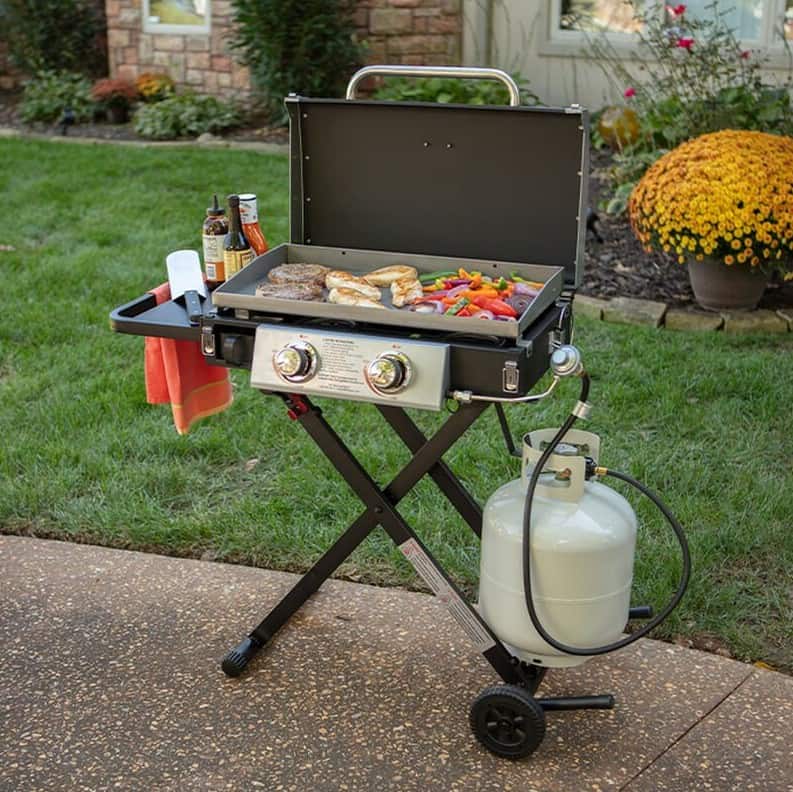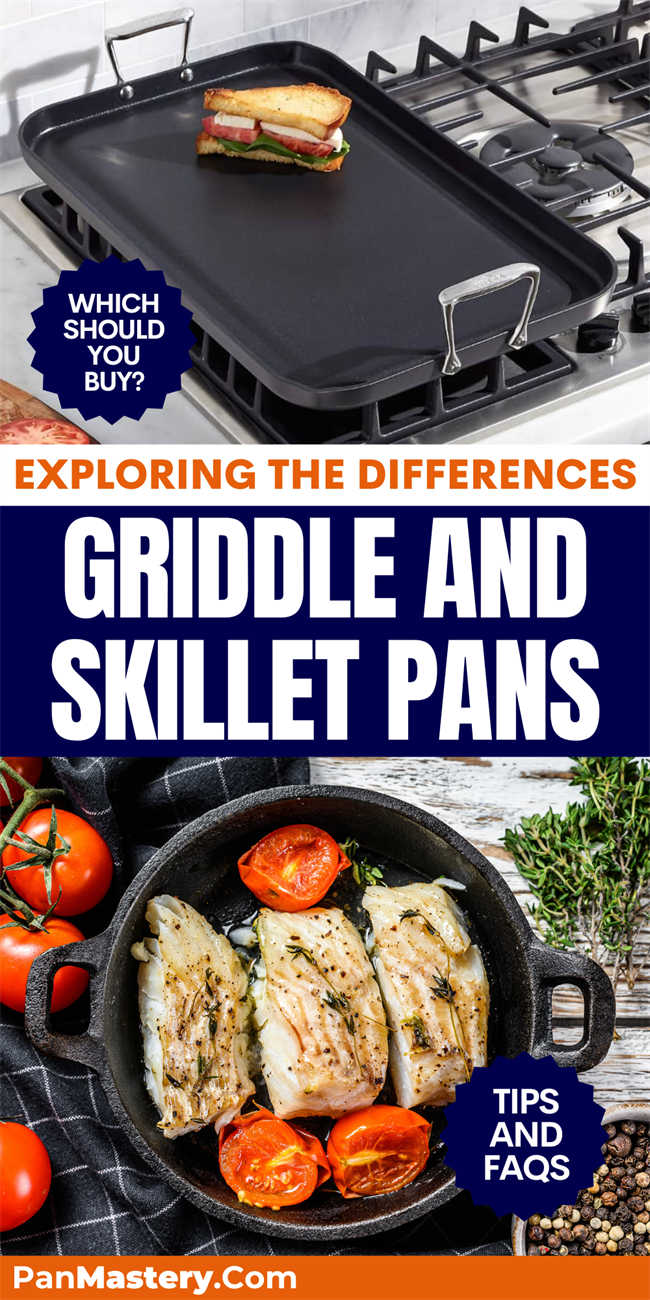As you start cooking, you will meet more and more cooking tools and equipment. As these tools and their details accumulate, the names and processes can get mixed up, and it could become harder to keep up with all the information. In these situations, it’s helpful to double-check. Let’s explore the differences between a griddle and a skillet.
Everything About Griddle

A griddle is a piece of cooking equipment with a flat surface and heat source underneath. This cooking equipment is deemed helpful by cooks as it is the best place to cook food that needs to be flipped.
One of the critical features of griddles is their shallowness. Unlike other cooking equipment, griddles are designed with much shallower edges making it the perfect equipment for preparing and cooking breakfast like pancakes, eggs, bacon, which usually requires a lot of flipping.
Griddles are most often associated with breakfast as it is usually used for cooking pancakes, French toasts, and hash browns, but a griddle can actually do more than that. Griddles can also accommodate burgers and sandwiches and other recipes that require a flat surface and ease for flipping.
Commercial griddle and flat tops

Commercial griddles accommodate more than the usual amount of recipes at once. These griddles are usually built into a range top. Commercial griddles are typically confused with flat top griddles as they look similar, but they work in different ways.
Commercial griddles are commonly seen in fast-food restaurants, burger shops, and many other stalls that sell fast-cooked food that requires a flat surface like patties, pancakes, and many other foods.
Commercial griddles and flat tops can be told apart by their cooking features. In a commercial griddle, food is placed and cooked directly on top of it, while in flat tops, both food and other cooking equipment like pots and pans can be placed on it.
A Closer Look into Griddles
Like other cooking equipment available out there, griddles can also be grouped differently depending on their individual purpose in the kitchen, energy source, size, style, and other specific features.
Griddle pan

Griddle pans are the perfect cooking equipment for smaller meals. Because these griddles are smaller, they also fit smaller kitchens or places where space is minimum. If you are operating in a smaller kitchen, perhaps an apartment kitchen or a smaller stall, you should consider purchasing a griddle pan.
Stovetop griddles

Stovetop griddles are traditionally used and have been a staple in many kitchens for years. You would probably remember seeing them earlier in the days used by your parents. These griddles are usually cast iron or aluminum and are placed directly on your stove. They are typically thicker than regular pans. These griddles are cheaper, but one of the downsides of them is that they are challenging to clean.
Gas griddles

These large griddles are those you typically see in restaurants. They take up a considerable chunk of space and so, they can accommodate more ingredients at once and also cook them nicely. These griddles are also a bit more expensive than others for these extra and more extensive features.
Gas griddles can consume more space than other types of griddles, so you might want to allocate enough room for them. These griddles are great for larger kitchens, most probably restaurants and diners.
Electric griddles

These griddles are good heat conductors, and they heat up evenly too. Electric griddles are usually stand-alone, so they are relatively easy to clean.
Panini grills

These griddles are created for a more specific purpose which is to cook paninis. Although panini griddle grills allow other recipes, they work best with cooking paninis, waffles, and crepes.
What is a Skillet?
Skillets have been a handy tool in the kitchen. Skillets are sometimes confused with frying pans due to their similar shape and function. However, skillets and pans are different as frying pans are shallower, and skillets tend to be deeper and sometimes come with lids.
This equipment is generally used for frying food. Skillets are generally heavy and even heavier, depending on the materials used. Skillets are pretty flexible. You can stir fry, fry, make omelets, and many more, and you can prepare a whole dinner meal by just using a skillet.
Non-stick skillets

Non-stick technology has also made a name for itself in the cooking industry. Many people opt for non-stick cookware as they are suitable for food that usually gets stuck on the surfaces.
Non-stick skillets are best for cooking delicate and fragile foods like eggs, breaded cutlets, fish fillets, crepes, and pancakes. Non-stick skillets offer an easy flipping method and an easy transfer process of the food. Another advantage of a non-stick skillet is the easy cleaning process.
Cast iron skillets

This material has been proven and tested with time. It has been one of the oldest and most reliable materials for cooking. Cast iron may be slow in heating, but they heat evenly, allowing for your food’s even cook.
A lot of cookware enthusiasts also collect old cookware made from this material. This sturdy and highly durable material works well in high heat, making it perfect for frying, roasting, searing, and baking.
Ceramic skillets

These skillets are coated with ceramic non-stick coating, which helps in cutting down your use of oil. The non-stick ceramic coating used in these cookwares is more environmentally friendly than other available kinds of the non-stick coating.
Stainless steel skillets

Stainless steel has been a very popular material for cookware. These skillets are good heat conductors and do not rust, chip, or react with food. These features make this type of skillet ideal for cooking.
Copper skillets

Copper skillets are considered to be one of the high caliber stuff in cooking. They are quick to respond to any temperature changes making them very ideal for cooking as you can be able to control the heat more precisely. The precise control feature makes copper skillets the best for sauteing, frying, quick sears, simmering, and browning.
Griddle and Skillets: Are They the Same?
The quick answer to the question “Are griddles and skillets the same?” is no. They are not the same, but they may share one or two similarities. When talking about griddle plates, there will be no similarities with skillets.
Seldom similarities
Griddles usually have ridges, but there are models that do not contain these ridges. The ridges are designed to leave grill marks and drain fats accumulated on the surface. The models without ridges now resemble skillets that have flat and smooth surfaces.
Differences
For griddles and skillets, there are more differences than similarities, so it could be concluded that they are different from each other in so many ways. Therefore, they are not the same.
- Shape and size – Griddles are generally larger in size and are usually square or rectangular in shape.
- Surface area – Skillets have flat surfaces, while griddles have raised surfaces designed to leave sear marks.
- Walls – Griddle pans have low walls, while skillets are designed to have higher walls.
Griddle vs. Skillet Showdown

Taste
Using a griddle and a skillet will indeed have a difference in terms of taste. Using a griddle provides you with a smokier and better taste, while the skillet is not designed to accommodate a more robust and smoky flavor. For this round, griddle wins.
Surface area
Since griddles are larger in size, they can accommodate more significant amounts of food, while skillets accommodate smaller portions of food. Again, griddles win, especially when you are inclined to cook more food.
Portability
Griddles are larger in size and are heavier. This makes them harder to move. On the other hand, skillets are more compact and are usually smaller. This creates a skillet more ideal when you cook something that requires a lot of moving and carrying. In this case, skillets win.

Price
Griddles are more expensive, while skillets are more affordable. If you are looking for cookware that will be used regularly and if you have a budget to follow. In terms of which is more affordable, skillets win.
Location: Indoor cooking
These griddles are usually used outdoors as they typically require a larger space compared to skillets. It would be inadvisable to place your griddles indoors. On the other hand, skillets are perfect for indoor cooking. In this round, if you are purchasing for indoor use, skillets are the winner.
Location: Outdoor cooking
In terms of cooking outdoors, griddles are more suitable than skillets. Although skillets are okay when used outdoors, this round belongs to griddles.
Grilling
Griddles are designed chiefly for grilling. Griddles create excellent sear marks and give an extra smoky effect on the food. On the other hand, Skillets are not as equipped for grilling as griddles. Griddles won this round.
Summary
In choosing cookware, it’s essential to know the right one and the specific cookware to avoid any hassle or wasted purchase. When contemplating purchasing a griddle or a skillet, it’s important to know each of their characteristics. When confused between a griddle vs. skillet, it’s essential to get to know their similarities and differences.


Michael Johnson is the founder of Pan Mastery, Inspired by his blacksmith grandfather’s legacy has a deep appreciation for hand-crafted pots and pans, he provides invaluable guides, reviews, and recipes to enhance your culinary journey.
